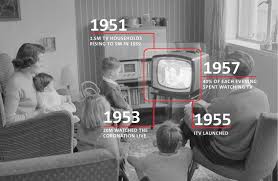
1950s Communication Technologies
In this assignment, you’ll recreate some of the experiences of a person who was involved with 1950s communication technologies. (Involved with covers a lot of territory, as you’ll see from the examples below.) You have considerable choice in terms of your topic and the form your project takes.
This 1950s Communication Technologies assignment has several goals. It’s designed to make concrete people’s engagement with technology: What did people a half century ago do with media technologies? And what did they think about them? Thus, you’ll be looking at technologies from a specific perspective. Also, you should get some sense of how people’s experiences then are the same as, or different than, people’s experiences today. The assignment should also sharpen your skills in digging out information from a variety of sources, especially primary sources. 1950s Communication Technologies And the assignment is structured so that you can use your imagination to immerse yourself in an historical moment.
Examples
The following examples suggest a range of possibilities. Remember, though, that these are examples; you are free to use them, modify them, or come up with your own. Imagine that
You’re a suburban teenager in the 1950s: What communication media do you use to share personal information with your friends (other than by talking)?
You’re a reporter for a TV station in Seattle (or New York, or a small town): What media technologies affect the way you work?
You manage a small office in Chicago: What office technologies do you use to prepare messages and communicate with clients or customers?
You’re president of NBC television’s entertainment division: What technologies affect your programming?
You’re a candidate for U.S. Senate: What media technologies do you use for your campaign?
You’re a twenty-something professional beginning a career in New York City: What media technologies provide entertainment for your after-work fun?
You work in a New York City advertising agency (like Mad Men): How are changes in media technology affecting your work?
You’re one of two telephone operators in a small Oregon town: What was your workday like?
You’re a reporter for the New York Times covering Asia: What technologies affect the way you write and transmit stories back to the States?
You’re a motion picture producer in Hollywood: What technologies affect the latest film you’re producing?
You’re a budding rock ‘n’ roll singer: What technologies affect your performances and recordings?
You’re an activist in the PTA (or a child psychologist) who’s concerned about the effects of TV on children: What evidence is there about the consequences of children’s exposure to television? What proposals would you make to protect children?
You’re the head of research for a TV network: What evidence is there, and what arguments would you make, to prevent government from regulating television because of its possible effects on children?
Dimensions of Your Topic
The examples above, and the ones you develop, all have multiple dimensions related to media technology in the 1950s. Your project does not have to explore every imaginable dimension, but it should address more than one. The scope of your project should expand with the size of your group if you’re not working alone.
Some dimensions that you might consider as you develop your topic:
People’s use of a technology varies by geography (urban/rural, East/West), income, race, language, age, and more. Consider these variables as you select a person’s perspective–the vantage point from which you view the technology–and your topic.
Technologies—and everything else—changed during the 1950s. So you might note what changed in this time period with your technologies.
Rules govern technologies. And rules come in different kinds. Some rules have the force of law behind them (e.g., government regulation of technologies). Others are industrial or business rules. Still others involve professional conventions or social rules—what’s appropriate behavior?
People have expectations of technologies.
Significantly, almost no technology works alone and many are systems with different components. All the examples above (and your project) involve two or more technologies. Although you might focus on one technology or technological system, you should also consider complementary and competing technologies.
What You’ll Produce
You’ll produce a paper, a web site, or PowerPoint report—you choose. Your project should briefly describe the type of person—location, general age, etc.—from whose vantage point you’re examining the technologies. One paragraph is enough. Your report should then briefly sketch the state of the relevant technologies in the 1950s (maybe noting major changes during the decade). After that, you have a lot of choices, but the basic goal is to recreate the experience of a person engaging with the technologies: their purposes, advantages and disadvantages, costs, rules, content, and anything else that’s relevant.
What You’ll Produce
You’ll produce a paper, a web site, or PowerPoint report—you choose. Your project should briefly describe the type of person—location, general age, etc.—from whose vantage point you’re examining the technologies. One paragraph is enough. Your report should then briefly sketch the state of the relevant technologies in the 1950s (maybe noting major changes during the decade). After that, you have a lot of choices, but the basic goal is to recreate the experience of a person engaging with the technologies: their purposes, advantages and disadvantages, costs, rules, content, and anything else that’s relevant. 1950s Communication Technologies
Deliverables”
“Deliverables” is the term businesses use in dealing with consultants and others to indicate precisely what should be produced and submitted.
We can write this or a similar paper for you! Simply fill the order form!
